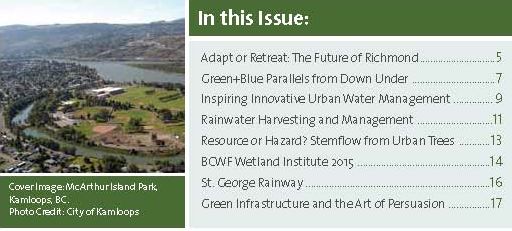GREEN+BLUE INFRASTRUCTURE: “Every author has emphasized how intertwined the social and economic dimensions of our ‘watershed assets’ are with their ecological benefits,” wrote Julie Schooling, Sitelines magazine co-editor (Oct 2016 issue)
Note to Reader:
Sitelines magazine is a publication of the British Columbia Society of Landscape Architects (BCSLA). Published bi-monthly, BCSLA has a longstanding practice of inviting partner organizations or individuals to take on a co-editor role and provide the content for an issue. Julie Schooling was responsible for developing the storyline and overseeing story development for the October 2016 issue.
Download Green + Blue Infrastructure to read the complete set of articles published in the October 2016 issue.
Acknowledgment: BC Society of Landscape Architects.
What is a Blue-Green City?
The Blue-Green Cities Research Project was led by Prof Colin Thorne, University of Nottingham, and ran from 2013-2016. Nine UK Universities were involved in addition to numerous academic, industry and local government partners.
A Blue-Green City aims to recreate a naturally oriented water cycle while contributing to the amenity of the city by bringing water management and green infrastructure together.
This is achieved by combining and protecting the hydrological and ecological values of the urban landscape while providing resilient and adaptive measures to deal with flood events.
Blue-Green Cities generate a multitude of environmental, ecological, socio-cultural and economic benefits.
The Research Consortium developed new strategies for managing urban flood risk as part of wider, integrated urban planning intended to achieve environmental enhancement and urban renewal in which multiple benefits of Blue-Green Cities are rigorously evaluated and understood.
To Learn More:
Visit http://www.bluegreencities.ac.uk/bluegreencities/index.aspx
Editor’s Perspective on the ‘Green+Blue’ Storyline
 “When I started brainstorming about this issue of Sitelines with Ray Visser and Keith Nyhoff, I believed the articles would focus on the technical and environmental aspects of green infrastructure as it relates to water quantity and quality,” wrote Julie Schooling in her op-ed preface to the set of articles.
“When I started brainstorming about this issue of Sitelines with Ray Visser and Keith Nyhoff, I believed the articles would focus on the technical and environmental aspects of green infrastructure as it relates to water quantity and quality,” wrote Julie Schooling in her op-ed preface to the set of articles.
“And yet every author has emphasized how intertwined the social and economic dimensions of our ‘watershed assets’ are with their ecological benefits.”
ADAPT OR RETREAT: THE FUTURE OF RICHMOND:
“Kevin Connery leads off with the global-scale challenge of sea-level rise, and imagines solutions in Richmond inspired by case studies in New York and Europe (but how to gain public buy-in to difficult decisions?).”
GREEN+BLUE PARALLELS FROM DOWN UNDER:
“Kim Stephens draws parallels between made-in-BC solutions and those ‘Down Under,’ noting cultural differences but the common need to adapt.”
INSPIRING INNOVATIVE URBAN WATER MANAGEMENT:
“Randy Sharp and Amy Greenwood introduce us to ‘Salmon-Safe’ certification, and present an inspiring case study of the award-winning Mountain Equipment Co-op Head Office in Vancouver.”
RAINWATER HARVESTING AND MANAGEMENT:
“Ken Nentwig describes rainwater harvesting and management tools and practices along with incentive approaches to motivate adoption of the techniques!
RESOURCE OR HAZARD? STEMFLOW FROM URBAN TREES:
“I then invite you to “think like a raindrop” as I share highlights of my MScES thesis project on tree characteristics that can influence site hydrology.”
BCWF WETLAND INSTITUTE 2015:
“Christina Walkden outlines her experience at the seven-day Wetland Institute held by the BC Wildlife Federation: she emphasizes that her interactions with other participants, from various disciplines and walks of life, was a highlight in itself!”
ST. GEORGE RAINWAY:
“Sarah Primeau uses images to pique our curiosity about the St George Rainway: a community deeply engaged, and a younger generation motivated to action!”
GREEN INFRASTRUCTURE AND THE ART OF PERSUASION:
“Finally, Shasta McCoy issues a challenge to all of us to tackle “watershed illiteracy and suburban aesthetic preferences” by appealing to people’s values and emotions – by fundamentally rebranding Green+Blue Infrastructure, one bioswale at a time!”




